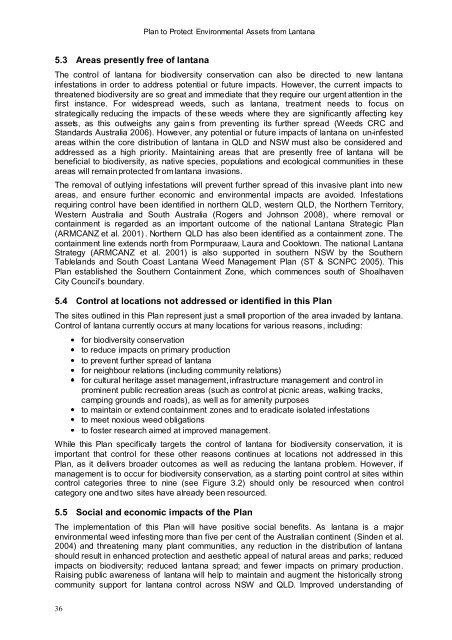Plan to Protect Environmental Assets from Lantana - Weeds Australia
Plan to Protect Environmental Assets from Lantana - Weeds Australia
Plan to Protect Environmental Assets from Lantana - Weeds Australia
You also want an ePaper? Increase the reach of your titles
YUMPU automatically turns print PDFs into web optimized ePapers that Google loves.
<strong>Plan</strong> <strong>to</strong> <strong>Protect</strong> <strong>Environmental</strong> <strong>Assets</strong> <strong>from</strong> <strong>Lantana</strong><br />
5.3 Areas presently free of lantana<br />
The control of lantana for biodiversity conservation can also be directed <strong>to</strong> new lantana<br />
infestations in order <strong>to</strong> address potential or future impacts. However, the current impacts <strong>to</strong><br />
threatened biodiversity are so great and immediate that they require our urgent attention in the<br />
first instance. For widespread weeds, such as lantana, treatment needs <strong>to</strong> focus on<br />
strategically reducing the impacts of these weeds where they are significantly affecting key<br />
assets, as this outweighs any gains <strong>from</strong> preventing its further spread (<strong>Weeds</strong> CRC and<br />
Standards <strong>Australia</strong> 2006). However, any potential or future impacts of lantana on un-infested<br />
areas within the core distribution of lantana in QLD and NSW must also be considered and<br />
addressed as a high priority. Maintaining areas that are presently free of lantana will be<br />
beneficial <strong>to</strong> biodiversity, as native species, populations and ecological communities in these<br />
areas will remain protected <strong>from</strong> lantana invasions.<br />
The removal of outlying infestations will prevent further spread of this invasive plant in<strong>to</strong> new<br />
areas, and ensure further economic and environmental impacts are avoided. Infestations<br />
requiring control have been identified in northern QLD, western QLD, the Northern Terri<strong>to</strong>ry,<br />
Western <strong>Australia</strong> and South <strong>Australia</strong> (Rogers and Johnson 2008), where removal or<br />
containment is regarded as an important outcome of the national <strong>Lantana</strong> Strategic <strong>Plan</strong><br />
(ARMCANZ et al. 2001) . Northern QLD has also been identified as a containment zone. The<br />
containment line extends north <strong>from</strong> Pormpuraaw, Laura and Cook<strong>to</strong>wn. The national <strong>Lantana</strong><br />
Strategy (ARMCANZ et al. 2001) is also supported in southern NSW by the Southern<br />
Tablelands and South Coast <strong>Lantana</strong> Weed Management <strong>Plan</strong> (ST & SCNPC 2005). This<br />
<strong>Plan</strong> established the Southern Containment Zone, which commences south of Shoalhaven<br />
City Council’s boundary.<br />
5.4 Control at locations not addressed or identified in this <strong>Plan</strong><br />
The sites outlined in this <strong>Plan</strong> represent just a small proportion of the area invaded by lantana.<br />
Control of lantana currently occurs at many locations for various reasons, including:<br />
for biodiversity conservation<br />
<strong>to</strong> reduce impacts on primary production<br />
<strong>to</strong> prevent further spread of lantana<br />
for neighbour relations (including community relations)<br />
for cultural heritage asset management,infrastructure management and control in<br />
prominent public recreation areas (such as control at picnic areas, walking tracks,<br />
camping grounds and roads), as well as for amenity purposes<br />
<strong>to</strong> maintain or extend containment zones and <strong>to</strong> eradicate isolated infestations<br />
<strong>to</strong> meet noxious weed obligations<br />
<strong>to</strong> foster research aimed at improved management.<br />
While this <strong>Plan</strong> specifically targets the control of lantana for biodiversity conservation, it is<br />
important that control for these other reasons continues at locations not addressed in this<br />
<strong>Plan</strong>, as it delivers broader outcomes as well as reducing the lantana problem. However, if<br />
management is <strong>to</strong> occur for biodiversity conservation, as a starting point control at sites within<br />
control categories three <strong>to</strong> nine (see Figure 3.2) should only be resourced when control<br />
category one andtwo sites have already been resourced.<br />
5.5 Social and economic impacts of the <strong>Plan</strong><br />
The implementation of this <strong>Plan</strong> will have positive social benefits. As lantana is a major<br />
environmental weed infesting more than five per cent of the <strong>Australia</strong>n continent (Sinden et al.<br />
2004) and threatening many plant communities, any reduction in the distribution of lantana<br />
should result in enhanced protection and aesthetic appeal of natural areas and parks; reduced<br />
impacts on biodiversity; reduced lantana spread; and fewer impacts on primary production.<br />
Raising public awareness of lantana will help <strong>to</strong> maintain and augment the his<strong>to</strong>rically strong<br />
community support for lantana control across NSW and QLD. Improved understanding of<br />
36

















